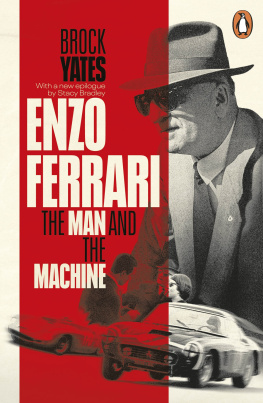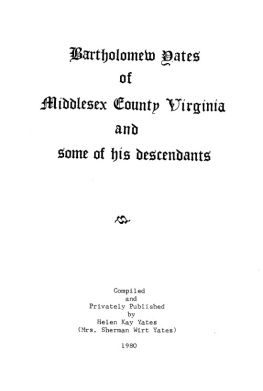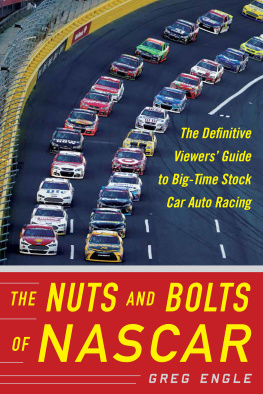Brock Yates - NASCAR Off The Record
Here you can read online Brock Yates - NASCAR Off The Record full text of the book (entire story) in english for free. Download pdf and epub, get meaning, cover and reviews about this ebook. year: 2004, publisher: Motorbooks, genre: Detective and thriller. Description of the work, (preface) as well as reviews are available. Best literature library LitArk.com created for fans of good reading and offers a wide selection of genres:
Romance novel
Science fiction
Adventure
Detective
Science
History
Home and family
Prose
Art
Politics
Computer
Non-fiction
Religion
Business
Children
Humor
Choose a favorite category and find really read worthwhile books. Enjoy immersion in the world of imagination, feel the emotions of the characters or learn something new for yourself, make an fascinating discovery.

- Book:NASCAR Off The Record
- Author:
- Publisher:Motorbooks
- Genre:
- Year:2004
- Rating:4 / 5
- Favourites:Add to favourites
- Your mark:
- 80
- 1
- 2
- 3
- 4
- 5
NASCAR Off The Record: summary, description and annotation
We offer to read an annotation, description, summary or preface (depends on what the author of the book "NASCAR Off The Record" wrote himself). If you haven't found the necessary information about the book — write in the comments, we will try to find it.
NASCAR Off The Record — read online for free the complete book (whole text) full work
Below is the text of the book, divided by pages. System saving the place of the last page read, allows you to conveniently read the book "NASCAR Off The Record" online for free, without having to search again every time where you left off. Put a bookmark, and you can go to the page where you finished reading at any time.
Font size:
Interval:
Bookmark:
OFF THE
RECORD
BROCK YATES

First published in 2004 by Motorbooks, an imprint of MBI Publishing Company, 400 First Avenue North, Suite 300, Minneapolis, MN 55401 USA
Copyright 2004, 2010 by Brock Yates Hardcover edition published in 2004. Digital edition 2010.
All rights reserved. With the exception of quoting brief passages for the purposes of review, no part of this publication may be reproduced without prior written permission from the Publisher.
The information in this book is true and complete to the best of our knowledge. All recommendations are made without any guarantee on the part of the author or Publisher, who also disclaims any liability incurred in connection with the use of this data or specific details.
We recognize, further, that some words, model names, and designations mentioned herein are the property of the trademark holder. We use them for identification purposes only. This is not an official publication.
Motorbooks titles are also available at discounts in bulk quantity for industrial or sales-promotional use. For details write to Special Sales Manager at MBI Publishing Company, 400 First Avenue North, Suite 300, Minneapolis, MN 55401 USA.
To find out more about our books, visit us online at www.motorbooks.com.
Digital edition: 978-1-61060-067-5
Hardcover edition: 978-0-7603-1726-6
Edited by Darwin Holmstrom
Designed by Rochelle Schultz
Printed in the United States of America
A TOUGH TOUR WITH COTTONS
STOCK CARS
DAYTONA 1966:
ALMOST A RUNAWAY FOR RICHARD
GO LEEROY:
A WILD RIDE AT DAYTONA
WHISKEY TRIPPIN BEGINNINGS
T he France family didnt invent stock car racing any more than James Watt and Thomas Edison invented electricity, but in both cases they perfected and expanded the diverse commodities into omnipresent elements of modern society. By the time William Henry Getty France Sr. arrived in Daytona Beach in the spring of 1934 with his wife, Anne, and 1-year-old son, William Jr., his life was committed to the booming world of automobiles and motorsports.
A native of backwater Horse Pasture, Virginia, 28-year-old France had been raised in Washington, D.C., where, as a spindly 6-foot, 5-inch high schooler, he had excelled in basketball. As a young boy, his father had taken him to the incredible 1.125-mile, high-bankedan amazing 48 degreesboard track at Laurel, Maryland, where he had seen superstars like Ralph DePalma, Jimmy Murphy, and Tommy Milton skate their Millers and Duesenbergs around the wall-like corners at over 130 miles per hour. When his future as an auto mechanic, part-time racer, and gas station operator seemed bleak in the depression-ravaged capital district, he loaded up his family and headed south.
Legend would have it that the was driving to Miami, but drew up in Daytona Beach, 300 miles short of his goal, when his haggard Hupmobile sedan broke down. France would later discount this as nonsense, noting that as a mechanic, he could easily have repaired the old flivver and continued his journey. Daytona Beach was an obvious destination for a young motorhead, its vast expanse of breathtaking beach having been the scene of high-speed record attempts since the adventures of William Kissom Vanderbilt and Alexander Winton in the early years of the century. The beach had subsequently been the scene of countless assaults on the land speed record, including the tragic loss of Indy winner and self-taught design genius 26-year-old Frank Lockhart, when his tiny, bulletlike Stutz Blackhawk blew a tire at over 220 miles per hour on April 25, 1928. Later that same year, future Indy 500 winner Ray Keech set the LSR at 207.552 miles per hour with his ungainly four-ton White Triplex Special. In 1935, Sir Malcolm Campbell, aboard his Rolls-Royce aircraft engine-powered Bluebird, would run 276.82 miles per hour, the fastest speed ever recorded at Daytona Beach.
It was therefore understandable that Bill France would settle in this hotbed of high performance. He was an experienced race driver, having built and competed with several home-built single-seaters up north. While stock car racing existed, it still was a primitive, rural sport involving crude, backyard jalopies running on cow pastures in the outbacks of the nation.
There existed a thriving industry in high-performance parts for Ford engines, especially since Henry Fords ultrahot flathead V-8 had hit the market in 1932. On the West Coast, the hot rod movement was running at full bore, with thousands of young men converging on the dry lakes at Muroc, Rosamond, El Mirage, and many others each weekend to run match races. In the South, Prohibition had only accelerated the regions tradition of distilling liquor without federal taxation, and bootlegging had become a major industry in the hardwood forests of the Piedmont Plateau. The transportation of white lightning fell into the hands of expert drivers who began whiskey trippin, i.e., the high-speed hauling of the illegal booze from the hidden mountain stills to the major cities of the East Coast. With their rise came expert shade tree mechanics who, employing the speed equipment developed by West Coast hot rodders and their own ingeniousness, created blindingly fast coupes that could easily outrun the police and federal revenue agents stock sedans.
By the 1930s, stock automobile racing had become a cheap and popular form of motorsport in most parts of the nation, but particularly on the Piedmont Plateau. There, the men who had honed their skills hauling liquor on the open roads began to run their modified Fords (called Henrys), Chevrolets (Stovebolts), Buicks (Joe Lewises) and Lincolns (Big Henrys) in patchwork races organized on crude, red-clay ovals carved out in small towns like Mt. Airy, Hickory, and Jonesville in North Carolina and Stockbridge in Georgia.
The races were ad hoc affairs, run on Sunday afternoons when liquor hauling was generally suspended in respect for the deep religious convictions of the rural South. No part of the nation had suffered more from the Depression. There being little industry besides the cotton mills, which paid a pittance for a weeks hard labor, and with national demand for clothing at a nadir, the illegal liquor business offered a decent, if dangerous, living for daring young country boys. Bootlegging remained a viable business, even following the end of the Volstead Act, the 18th Amendment, and Prohibition in 1933.
A strange offshoot of the illegal liquor business was the creation of a class of expert driversdaredevils who could navigate the backcountry roads of the Piedmont with amazing skill. Their favored vehicles were lightweight Ford coupes with hot-rodded V-8 enginesmany built up by Atlanta engine genius Red Vogtand stiffened rear springs to permit the transport of up to 180 gallons of white liquor, carried in either Mason jars or aluminum milk cans.
The best drivers could make five or six trips a week. At $40 a run, they made big money, which permitted them a Sunday rumble with their rivals on roughed-out ovals in the backcountry. Thirty or 40 of the trippers often lined up to do battle. There being no formal admission, the drivers passed their leather football helmets through the crowd, collecting nickels and dimes that would be added to the pot, sweetened by private bets between the competitors.
In 1936, having lost the land speed record seekers to the vast expanses of the Bonneville Salt Flats in Utah, the Daytona Beach business community organized a race for street stock automobiles on a 3.2-mile course that utilized the ocean front beach and a parallel, inland macadam highway.
Font size:
Interval:
Bookmark:
Similar books «NASCAR Off The Record»
Look at similar books to NASCAR Off The Record. We have selected literature similar in name and meaning in the hope of providing readers with more options to find new, interesting, not yet read works.
Discussion, reviews of the book NASCAR Off The Record and just readers' own opinions. Leave your comments, write what you think about the work, its meaning or the main characters. Specify what exactly you liked and what you didn't like, and why you think so.









